Originating as a small agricultural experiment station library in 1888, the collections have evolved to their present comprehensive state embracing virtually all the life sciences, including biology, biochemistry, nutrition, nursing and public health. The long tradition as an agriculture library explains the large historical collections including major United States Department of Agriculture, Forest Service and State Experiment Station publications.
- 1888 - 1933 Experiment Station Library
- 1933 - 1968 Agricultural Library
- 1968 - 1974 Agricultural and Biological Sciences Library
- 1974 - To Date Life Sciences Library
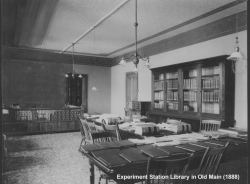 1888 - 1933 Experiment Station Library
1888 - 1933 Experiment Station Library
- 1888 Agricultural Library began as the Experiment Station Library on the second floor of Old Main.
- Julia Catherine Gray appointed as Agricultural Librarian. She serves until 1918.
- 1889 Moved to the new Experiment Station building (now Art Education Crafts).
- 1902 George Blight Endowment Fund of $5,000 was established to purchase books and journals in agriculture
- 1908 Library of 2,500 volumes again moved, this time to the new agriculture building (now Armsby).
- 1918 Kathryne M. Stanford appointed head of the Experiment Station Library. She serves until 1934
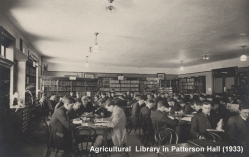 1933 - 1968 Agricultural Library
1933 - 1968 Agricultural Library
- 1933 Agricultural Library opened in Patterson Hall April 20. Julia Gray delivers a speech "The Early History of the Penn State Agricultural Library"
- 1934 Elizabeth Beal is appointed head of the Agricultural Library. She serves until 1938.
- 1938 Anna E. Malone is appointed head of the Agricultural Library. She serves until 1966.
- 1943 The Library had 32,000 volumes with reading rooms in the Forestry Building (now Ferguson) and the Institute of Animal Nutrition (in Armsby).
- 1949 Budget for books and journals reached $7,500; by 1987 the materials budget was $450,000.
- 1952 Library began experiencing rapid growth and crowded conditions; during the period up to 1957, 15,800 volumes were added.
- 1959 No increase in space since 1940 created desperate situation, with books piled on floor, radiators, and window sills.
- 1961 Plans were made for consolidation of library service in new addition to main library. Agriculture and zoology were among the subjects assigned to Penn State Libraries as a State Regional Resource Center.
- 1962 School of Forestry Library was added to the Agricultural Library. Most collections were moved to Leete Hall during renovation of Patterson.
- 1966 Agricultural Library was moved to Pattee, C107 (now the Knowledge Commons) but crowded conditions were unrelieved.
- Miriam D. Pierce serves for part of 1966 as head of the Agricultural Library.
- Vladimir Micuda is appointed head of the Agricultural Library. He serves until 1977.
1968 - 1974 Agricultural and Biological Sciences Library
- 1968 Name was changed to Agricultural and Biological Sciences Library. Collection totaled 87,930 volumes and 1,461 journals.
- 1969 Site dedication of East Pattee was held July 3 with Agricultural and Biological Sciences Library slated to occupy 1 1/2 floors.
- 1971 Applied Mycology was assigned to Penn State as a subject specialty under proposed National Agricultural Library Network. Collection had grown to 105,436 volumes and 1,789 journal subscriptions.
- 1972 Library moved to East Pattee, where it occupied 70 percent of shelf space on the second floor.
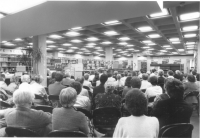 1974 - To Date
1974 - To Date
- 1974 Name was changed to Life Sciences Library; CAIN on-line computerized bibliographic data base service began with research grant from the National Agricultural Library. Holdings were 125,000 volumes; Library experienced 5 percent cut in serials budget.
- 1977 Keith E. Roe is appointed head of the Life Sciences Library. He serves until 1990.
- 1979 Kneebone Mushroom Reference Collection is established with gift of the personal library of Leon R. Kneebone, Professor Emeritus of Botany and Plant Pathology, who continues to provide funds for collection development. The collection includes works on the economics, cultivation and culinary uses of mushrooms and the history and mythology of mushrooms.
- 1981 Land Grant Agricultural Publications Microfilming Project began in cooperation with the National Agricultural Library. Penn State Libraries serve as coordinator.
- 1985 To reduce crowding, materials were placed in the library annex, and accessible storage facility in the Academic Services Building. A microcomputer was made available for cataloging and data base searching.
- 1988 Celebrated the 100th Anniversary of the Agriculture Library. Keith Roe delivers remarks "History of the Agricultural Library at Penn State 1888-1988"
- Collection size was approximately 270,000 volumes and 3,000 current journal subscriptions received and serviced by eight full-time library faculty and staff.
- 1990 Katherine E. Clark is appointed head of the Life Sciences Library. She serves until 1995.
- Librarians receive microcomputers for their offices.
- 1993 The Medline database is made available on the Libraries' LIAS system.
- 1994 The Journal of Extension becomes available in online format only, the first life sciences journal to do so.
- 1995 Amy L. Paster is appointed head of the Life Sciences Library. She served until 2020.
- The Agricola database is made available on the Libraries' LIAS system.
- 1996 The Life Sciences Library's first internet home page was created.
- 1996 The Life Sciences Library participates in the USAIN State and Local Agriculture and Rural Life preservation proposal to NEH, eventually filming 1,145 volumes (336 monographs and 809 serials) of Pennsylvania agricultural literature published between 1820 and 1945. The project is completed in 1999.
- 1997 The National Library of Medicine releases PubMed, free, direct access to MEDLINE via the World Wide Web.
- 1998 The National Agricultural Library gave the world free on-line access to AGRICOLA, the library's database of more than 3.5 million records of agricultural information.
- 2000 Library moved to the 4th floor of the new Paterno Library, which encompasses the previous East Pattee space (now renovated), plus additional newly constructed space.
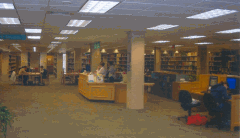
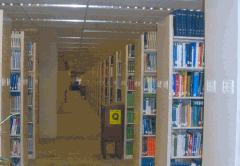
- 2003 The George Harvey Fly Fishing Literature Collection is established to supplement the current holdings on fly fishing, fly tying, aquatic entomology, fish species of importance to fly fishing and related angling topics described by prominent fly fishing authors.
- 2006 Lancaster Farming (1955-1983) the leading Northeast and Mid-Atlantic farm newspaper is digitized and made available free online.
- 2007 The Life Sciences Library collections include over 300,000 volumes, 1,300 print journal subscriptions, access to over 10,000 online journals, and over 20 online indexes to life sciences materials.
- 2009 A group study area is created that includes a collaborative workstation, white board and seating for 50.
- 2011 A fifth full skeleton was added to the anatomical models collection. These items were checked out over 800 times during the year.
- 2012 A consultation room with media:scape equipment was created. This technology allows the librarians to work collaboratively with faculty and students.
- 2013 The Life Sciences Library celebrated its 125th anniversary in March.
- 2014 Digital signage went live allowing the Life Sciences Library to promote subject specific resources and events
-
2017 – Created three collaborative study spaces for students
-
2018 – Added first Virtual Reality resource for anatomy and kinesiology students
-
2019 – Anatomical model collection has grown to 9 skeletons, 11 skulls and 5 muscle models in addition to various other organs